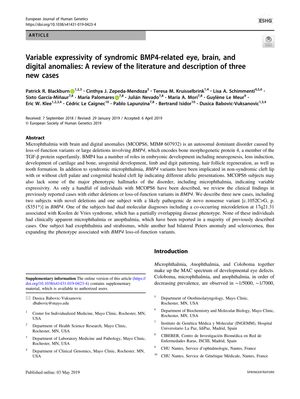Variable Expressivity of Syndromic BMP4-Related Eye, Brain, and Digital Anomalies: A Review of the Literature and Description of Three New Cases
May 2019
in “
European Journal of Human Genetics
”

TLDR BMP4-related anomalies can cause a wide range of eye, brain, and hand/foot problems, and new cases show this variability.
The document summarizes the variable expressivity of BMP4-related anomalies, particularly focusing on eye, brain, and digital abnormalities, and introduces three new cases of microphthalmia with brain and digital anomalies (MCOPS6). These cases, which did not all present with typical microphthalmia or anophthalmia, revealed a range of ophthalmological, brain-related, and limb abnormalities, such as exophthalmia, sclerocornea, ventricle dilatation, and postaxial polydactyly. The study, which included a review of 27 individuals, emphasized the wide clinical spectrum caused by BMP4 variants and the importance of considering multiple molecular diagnoses in atypical cases. It also added a new nonsense variant to the known BMP4 gene variants and suggested that future genomic approaches could further elucidate the phenotypic spectrum associated with BMP4 loss-of-function variants. The research was supported by the Mayo Clinic Center for Individualized Medicine and the DECIPHER Consortium, with no conflicts of interest reported by the authors.

